|
|
|
|

|

|
|
|
Fundamental biological processes that involve the conversion of energy
into forms that are usable for chemical transformations are quantum
mechanical in its nature. These processes involve chemical reactions
themselves, light absorption, formation of excited electronic states,
transfer of excitation energy, transfer of electrons and protons, etc.
Some other biological processes, e.g. orientation of birds in the
magnetic field of Earth, have been also suggested to require quantum
mechanics.
|
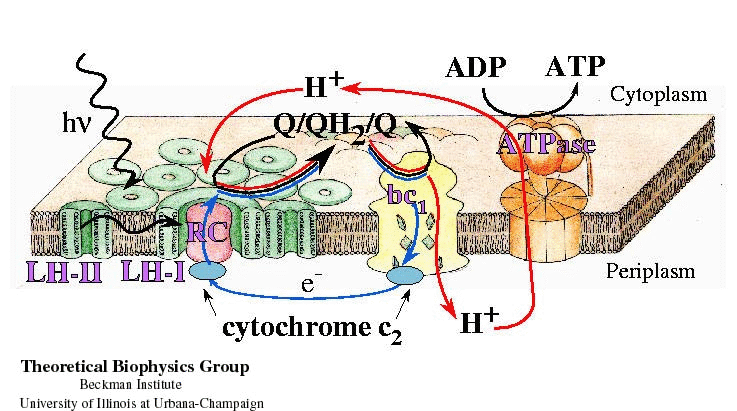
|
Summary of Quantum Processes required for ATP synthesis
The figure presents the scheme of the integral membrane
proteins forming the photosynthetic unit. Light-absorption and
excitation transfer within the light-harvesting proteins (LH-II and
LH-I) are represented by wavy lines. Electron transfer within the
photosynthetic reaction center (RC), cytochrome c2, and bc1 complex is
represented by blue lines. Proton transfer in the bc1 complex and the
ATPase is represented by red lines. The chemical reaction of ATP
synthesis is represented by a black line. |
|
The description of quantum processes in biological systems is usually
focused on specialized molecules, e.g., chlorophylls, which are
embedded in larger protein environment. The extremely challenging task
of describing the dynamics of such systems, involves several open
problems on which the Theoretical Biophysics Group is working on:
quantum mechanical description of large molecules (computational
demand for quantum description increases exponentially with the number
of particles), combined quantum/classical description (to treat
molecules which behave quantum-mechanically within the context of its
classical/protein environment), stochastic quantum mechanics combined
with molecular dynamics.
|
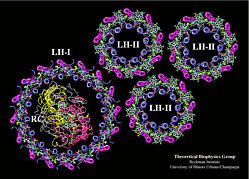
|
The photosynthetic unit of purple bacteria consists of the
photosynthetic reaction center, surrounded by light-harvesting
complexes. The initial step of photosynthesis, i.e., light-absorption
by chlorophylls and carotenoids in light-harvesting complexes and
transfer of excitation energy to the photosynthetic reaction center
are studied by quantum chemistry and effective Hamiltonian methods.
Figure produced with VMD .
|
In light-harvesting complexes, carotenoids act as
light-absorbers in the blue-green region of the spectrum. Absorption
of a photon is followed by rapid singlet excitation energy transfer to
bacteriochlorophyll (BChl). In addition to their light-harvesting
role, carotenoids photoprotect antenna complexes, i.e., they prevent
the formation of photo-oxidizing singlet oxygen by quenching BChl
triplet states through triplet excitation transfer. Light-harvesting
and photoprotection by carotenoids is studied in Theoretical
Biophysics Group in two proteins, the Light-Harvesting Complex II of
Purple Bacteria, and the Peridinin-Chlorophyll-Protein of
Dinoflagellates.
Figure produced with VMD .
|
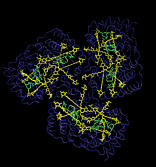 |
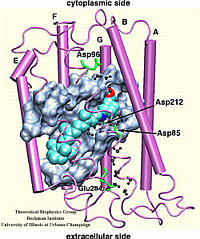
|
The all-trans retinal protonated Schiff base (RSPB) is the
chromophore of bacteriorhodopsin (bR), a transmembrane protein that acts
as a light-driven proton pump in Halobacterium salinarium,
converting light energy to a proton gradient. Upon absorption of light
the chromophore undergoes a photoisomerization process (all-trans
-> 13-cis) that eventually provides the driving force for the
translocation of protons. This elementary photoisomerization process
proceeds on multiple coupled potential energy surfaces and we have
modeled it using a formally exact quantum-mechanical procedure: the full
multiple spawning method. Currently, we are studying the first excited
electronic state of the chromophore using an isolated retinal analog
model and ab initio CASSCF methods. The characterization of the
first excited state (minima and conical intersections associated with
isomerization around different double bonds) will enable us to extend and
improve the aforementioned quantum-mechanical studies of the
photoreaction dynamics in the protein.
Figure produced with VMD .
|
| We study the suggestion that the geomagnetic field is
detected by changes in the rates and yields of radical pair
reactions. Assuming that photoreceptors involved in vision are
involved in radical pair reactions, the magnetic field will result in
a modulation of vision. The visual modulation patterns furnish animals
with magnetic compass capabilities as illustrated in the figure.
|
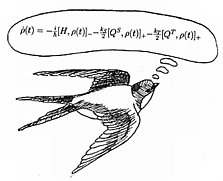 |
| | |